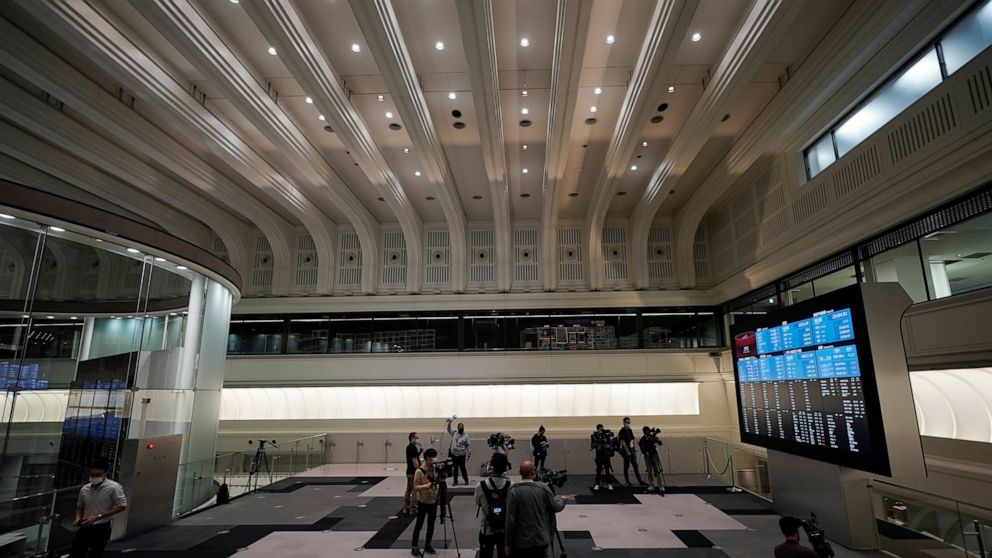Tokyo trading stops over system failure, China on holiday
Trading has been suspended on the Tokyo Stock Exchange because of a problem in the system for relaying market information
TOKYO — Trading on the Tokyo Stock Exchange was suspended Thursday because of a problem in the system for relaying market information. Most other Asian markets were closed for national holidays.
The Tokyo Stock Exchange said that all trading was stopped because of the problem, and will not resume for the rest of the day. It was unclear when it would be resolved and the system would be operating again.
Australia’s S&P/ASX 200 gained 1.6% by midday to 5,909.40. Trading was closed in South Korea and China for national holidays.
Details on the Tokyo trading problems were not immediately available. Japan’s nationally circulated Asahi newspaper, without citing sources, said the cause was likely a mechanical failure.
The Tokyo Stock Exchange is the world’s third largest bourse after the New York Stock Exchange and Nasdaq, with market capitalization of nearly $6 trillion.
Previous outages occurred when the “arrowhead” system created by Fujitsu to handle its electronic trading became overwhelmed with too many orders at one time.
That’s what happened on Oct. 9, 2018, according to a release on the TSE’s website. But during that disruption, some backup systems for trading continued to function.
The exchange promised to investigate, conduct malfunction tests and change the system to ensure that a flood of orders would not cause the entire system to stop working. Several top executives of the exchange were penalized.
On Wall Street, prospects for additional support from Congress for the economy helped drive the day’s trading, as they have for weeks. The S&P 500 shot to a gain of as much as 1.7% after Treasury Secretary Steven Mnuchin spoke positively on CNBC before his afternoon talks with House Speaker Nancy Pelosi — their first face-to-face meeting in more than a month in a last-ditch effort to seal a tentative accord on an additional round of coronavirus relief.
But the gains nearly vanished as pessimism rose about Washington’s ability to put aside partisanship and send economic aid that investors say is crucial. The S&P 500 hit its low for the day just after Pelosi said she and Mnuchin “found areas where we are seeking further clarification,” though she said talks will continue.
By the end of trading, momentum had returned, and the S&P 500 rose 0.8% to 3,363.00. The Dow Jones Industrial Average gained 1.2% to 27,781.70, and the Nasdaq composite 0.7%, to 11,167.51.
It was the last day of a strong quarter for the market, where the S&P 500 rallied 8.5% to follow up on its 20% surge in the spring. Continued support from the Federal Reserve helped drive the gains, as the central bank leaned further into the whatever-it-takes approach taken to support markets and the economy. After already cutting interest rates to nearly zero, the Fed said during the quarter that it may keep interest rates low even after inflation runs above its target level.
Other recent worries include rising tensions between the United States and China, as well as the uncertainties swirling around the upcoming U.S. elections.
Despite the rebound in the economy, the number of layoffs has remained stubbornly high. A report from payroll processor ADP on Wednesday said hiring by private employers accelerated this month, with 749,000 jobs added versus economists’ expectations for 605,000.
That raises hopes for the federal government’s more comprehensive jobs report, which arrives on Friday. Economists expecting to see hiring slowed to 850,000 from 1.4 million in August.
This month’s jobs report will take on even more importance than usual as it is the last one to be released before Election Day in November.
Tuesday night’s debate between President Donald Trump and the Democratic nominee, Joe Biden, was the first of this election season, and it amplified some of the market’s concerns. Trump said it may take months to learn the election’s results, and such a long period of uncertainty could make an already shaky market even more volatile.
In energy trading, benchmark U.S. crude lost 2 cents to $40.20 a barrel in electronic trading on the New York Mercantile Exchange. Brent crude, the international standard, fell 8 cents to $40.95 a barrel.
The dollar rose to 105.47 Japanese yen from 105.45 yen late Wednesday. The euro weakened to $1.1742 from $1.1746.
———
AP Business Writers Stan Choe and Damian J. Troise contributed.
![]()


